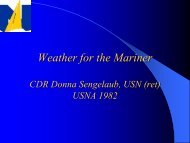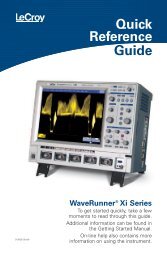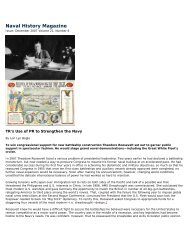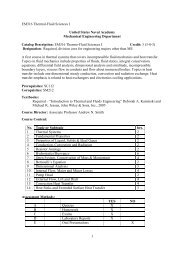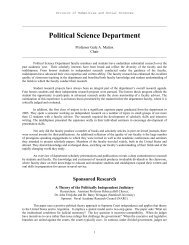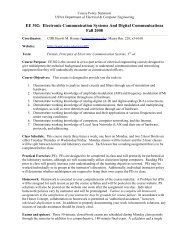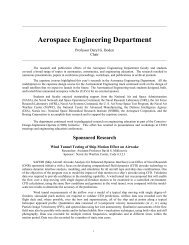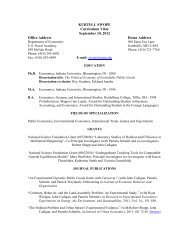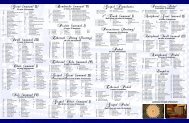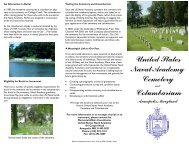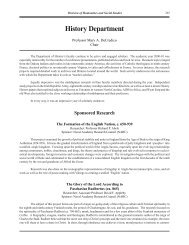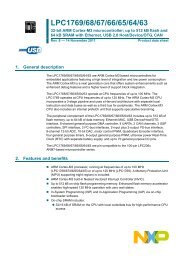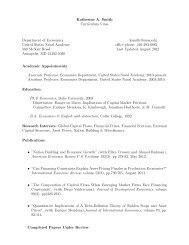Computer Science Department - United States Naval Academy
Computer Science Department - United States Naval Academy
Computer Science Department - United States Naval Academy
- No tags were found...
Create successful ePaper yourself
Turn your PDF publications into a flip-book with our unique Google optimized e-Paper software.
160 <strong>Computer</strong> <strong>Science</strong> <strong>Department</strong>High Energy Laser Weapons: Modeling and Simulation(Phase II, Modeling Development)Researcher: Associate Professor Donald M. NeedhamSponsor: The High-Energy Laser Joint Technology OfficeDevelopment of one or more end-to-end simulations of laser system performance and effectiveness is fundamentalto the goals of the High Energy Laser Joint Technology Office’s (JTO) modeling and simulation (M&S) program. Onesuch simulation prospective follows the physics and engineering of a ship’s energy starting with energy conversion fromthe ship’s fuel through electrical power generation, electrical generation of laser light, beam transport, etc, and ending withtarget damage assessment. A fundamental step, proposed by this research, in the process of developing a domain-reusable,end-to-end high energy laser simulation, was to examine an existing model, and focus on the identification of a softwaresystem architecture designed to support the inclusion of modeling components needed for the various portions of an endto-endsimulation. The steps in this process included acquiring a suitable high energy laser model, and developing an architecturethat isolated and minimized couplings between the software components that implemented the model. Analysisof the resulting architecture focused on increasing its potential for domain-specific reuse so that suitable models for theremaining portions of the end-to-end simulation could be smoothly integrated. Additionally, this work provided guidanceto high energy laser modelers on developing software components that implement their models so as to ease integration oftheir models within an end-to-end simulation.The Andes ProjectResearcher: Professor Kay G. SchulzeSponsor: Office of <strong>Naval</strong> Research (ONR)Classical physics is a prerequisite for virtually all university-level study of science and technology, yet is notoriouslydifficult for students to learn. The Andes project is an intelligent tutoring system that is intended to be used as a “homeworkhelper” for students taking General Physics courses. This year the project concentrated on expanding the number of problemsin the system, particularly in areas traditionally covered in a second semester Physics course.A Particle System Method for Quantifying Cardiac Ejection FractionResearcher: Assistant Professor David J. Stahl, Jr.Sponsors: Office of <strong>Naval</strong> Research (ONR) and <strong>Naval</strong> <strong>Academy</strong> Research Council (NARC)This research first required porting an existing physically-based modeling, visualization and physical simulationenvironment previously developed by the researcher, from its UNIX/SGI implementation to a Windows/PC implementation.Second, an existing volumetric model of a human left ventricle was improved to permit blood pool introduction andejection. This required data conversion and modification to produce an anatomically correct myocardium model with a leftatrium, aorta, and associated valves suitable for use in the simulation system. Third, the particle system model was revisedto allow temporally changing internal model representations to permit the modeling of cardiac valves that open and close.Finally, simulations were run to demonstrate the ability to measure cardiac ejection fraction with this approach.Independent ResearchAn Investigation into Compromise Actions in Behavior-Based Robotic SystemsResearcher: Assistant Professor Frederick L. Crabbe, IVThis project examined the nature of compromise actions in behavior-based systems. Using Value-Iteration toapproximate solutions to the Bellman equation, it determined the comparative advantage to selecting compromise actionswhen pursuing two appetitive goals. It then used Information Gain to determine in what scenarios compromise behaviorprovided the greatest benefit.



